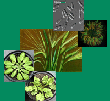| Senser, M; Schötz, F; Beck, E: Seasonal changes in structure and function of spruce chloroplasts, Planta, 126, 1-10 (1975), doi:10.1007/BF00389354 | |
| Abstract: Seasonal changes of ultrastructure were studied by electron microscopy and by determining the chlorophyll and starch content of the plastids. Young plastids of spruce (Picea abies (L.) Karst.) first function as amyloplasts which store reserve material for the growth of the young needles. Then they develop a normal thylakoid system and produce assimilation starch during the day. In autumn, starch synthesis ceases and the plastids group together. In winter they swell and their membrane system becomes disorganized and reduced. With increasing temperatures in spring the chloroplasts recover, but then they accumulate large amounts of starch, which is not broken down during the night or even during a dark period of several days. As in the previous year they now function as amyloplasts providing reserve material for the new shoot. In summer these plastids are again converted into typical chloroplasts. The same seasonal changes of structure and function could be observed in chloroplasts from 2- or 3-year old needles. Thus these changes represent cyclic processes, which repeat each year. Features of slow aging are superimposed on to these cycles. |

